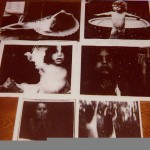Photography exhibit entitled “Phenomena+Existence No. 1” by artist Yelena Yemchuk.
In the front hall of Yelena Yemchuk’s exhibition at Dactyl Foundation are beautifully eerie female nudes, five large and eleven small works gracefully framed in matte charcoal. The triptychs seem to be about movement, like a bit of film. The diptychs experiment with depth of field and doubling. The single images are simply a moment arrested by thought, not frozen, but made alive by interpretation. These works would be the “phenomenal” part of the exhibition. Technically, the term phenomenon refers to a brute fact — plain, indisputable. It is simply what you see, a spatiotemporal object of sensory experience susceptible to scientific description. But phenomenon can also mean the opposite, a marvel, a thing of wonder and amazement. The word provides a useful ambiguity that describes Yelena’s work very well. Inhabiting each of these prints is what might be called a phenomenal pattern — discrete, separate, and stubborn facts that, because they are put into relation, can be interpreted in extraordinary ways.
Photography is, in some sense, the craft of brute fact. Objects are captured on film. But Yelena’s art takes objects into a space where things happen to them. Yelena attributes it to the spirit of the session that brings photographer, camera, and model together in the room and adds its own peculiar intention to the final image. Working in Polaroid 665 positive negative film, Yelena is able to change the body’s textures and shades like a painter or a poet would.
In the main room is the part of the exhibition that focuses on some fundamental or first element of existence. The sixteen large unframed prints are raw, depicting carnival scenes, naked little kids at play, and a grave young woman holding a dead animal above her head. These pieces seem to show the world through the eyes of strangers. Yelena spent 1998-2002 working on a documentary “mission,” possessed by that spirit perhaps, traveling from Eastern Europe, to Europe, to South America. She sought, found, and photographed strangers whom she recognized — as contradictory as that may sound. Different as they were, each from each, they all had an odd nonlocal correlation. “They all knew why I was photographing them.”
This is not reportage. This work is more psychological, as if the photographer had spend time talking to her subjects, but they wouldn’t always have been able to speak the same language and they wouldn’t always have been able to speak. But they are talking; that’s clear; somehow they just seem to be talking. The overall effect is surreal. The link is implied, but where exactly is the connection? The viewer is drawn in, like the photographer herself must have been. It almost looks as if a stage has been set, inviting her to become the audience, but this is no performance. It is life, the strangest most contrived play there is. Yelena has found the principal players, and her photographs seem to give us some hint of the script.
–Victoria N. Alexander
[nggallery id=42]

